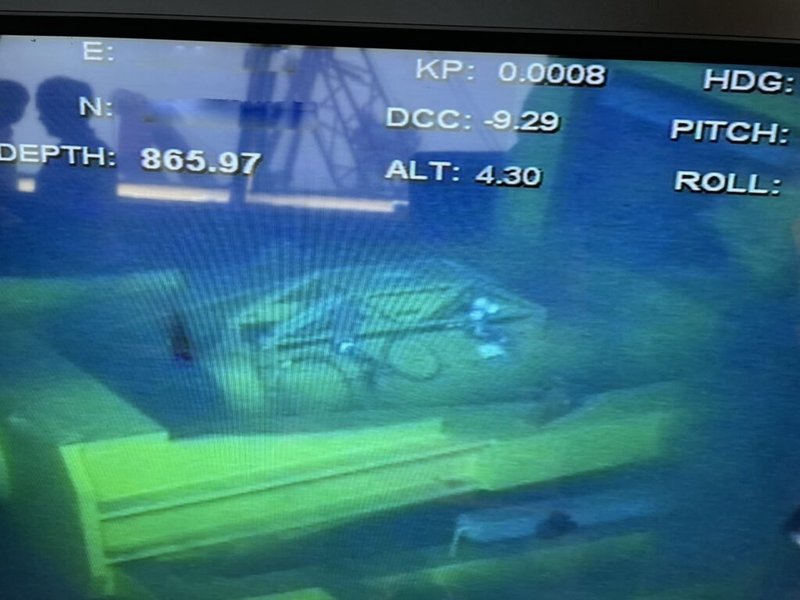- Home
- |
- Field cases
- |
- Installation of Subsea Corros…
Installation of Subsea Corrosion-Erosion Monitor (CEM) offshore India
Installation and configuration from vessel to seabed

Introduction
Håvard Pihlstrøm, one of our service engineers went to India in January 2024 for installation and configuration of one of our ClampOn Subsea Corrosion-Erosion Monitors (CEM) prior to deployment at a water depth of around 850 meter.
Functional testing of the Corrosion-Erosion Monitor
When Håvard arrived on the vessel from which installation would take place, the PLET (Pipeline and Termination) module was ready on deck. They lifted the electronics canister into place and installed it first before commencing functional testing. This functional testing and a software update took time due to a slow network connection. However, with excellent help from crew on board, the task was completed and the canister removed for safekeeping until later

Subsea CEM ready for functional testing
The A-frame and PLET module
On the night of 7th January the PLET module was moved onto what is called the "A-frame", which is a large frame with hydraulics and a winch used to bring the PLET module to a vertical position prior to welding it to the pipeline. It is impressive to see a 24" steel pipe arcing all the way upwards from a depth of over 800 metres to the ship where the PLET module is welded in place.

PLET module on the A-frame where the SS CEM is attached to
Rotating the electronic canister in place
Early on the 8th January, they finished welding and coating the pipe, and were then ready for final functional testing of the Subsea CEM. The electronics canister rotated elegantly in place, despite the Subsea CEM hanging vertically and the locking mechanism having to overcome gravity. The crew were impressed with the design

Final preparations before deploying the module subsea
Deployment of the PLET module and Subsea CEM
Functional testing went without a hitch and everything looked good. With a temperature of 30 degrees and a ship waiting for our engineer to complete his task, it was important to work effectively and with precision. Half an hour after he was finished, they commenced deployment of the PLET module subsea, and three hours later it was on the seabed with our Subsea CEM ready to aid safe operation.

The Subsea Corrosion-Erosion Monitor in place
Engineer`s assessment of the installation process
"It`s exciting to experience a country like India, and working from a ship was new to me. It has been a fantastic opportunity to work on our Subsea CEM as part of a larger installation. It was impressive to see the whole process, from short lengths of pipe to completed gas pipeline 850 metres below. Final testing of the Subsea CEM was carried out while the module was vertical prior to submersion, which meant challenging working conditions and extra safety measures while installing the electronics canister. Fortunately, the test went quickly and without a hitch, and the design worked just as well vertically as it does horizontally"

Håvard Pihlstrøm - ClampOn Engineer, Field Operations
Jobs done
We thank Håvard for his efforts and look forward to more projects of this type in the future

Sunset in India - Jobs done!
Advantages by using the ClampOn Subsea Corrosion-Erosion Monitor
Many governments and petroleum regulations require permanent monitoring of a pipe’s condition, and this instrument provides a constant stream of information about the pipe’s condition at critical points. By installing the Corrosion-Erosion Monitor, the operator can constantly monitor any changes in wall thickness and will know when, if necessary, to replace sections of a pipe, or if there is a risk of leakage caused by corrosion or erosion.
The Subsea ClampOn Corrosion-Erosion Monitor gives the operators real-time monitoring, it is non-intrusive, retrofit installable, has a large coverage area, and has a high resolution and accuracy.
A variety of system configurations are possible, ranging from standalone monitoring stations with internal data logging to full real-time integration into existing data infrastructure.
The CEM® is a versatile instrument and can be used to monitor different types of metal structures, for example, manifolds, pipelines and jumpers
Additional information
ClampOn Corrosion-Erosion Monitor - Videos
Short introduction of the Corrosion-Erosion Monitor with focus on the Subsea version of the instrument - Presented by Anja Bilsbak - Sales & Marketing
Area Sales Manager Eirik Walle, explains details of subsea Corrosion-Erosion Monitor ready for shipment.
Field cases
-

23.10.25
Subsea Non-intrusive Flow Temperature Monitoring on long subsea gas pipeline
ClampOn was tasked with developing a solution for temperature monitoring along a long subsea gas pipeline from a large offshore field
-

09.12.24
What can we do to prevent choke failure?
Helping the operator by using ClampOn Choke Condition Monitor to avoid producing with a choke at an opening that can cause high vibration or sound pressure levels
-

02.12.24
The Subsea Corrosion-Erosion Monitor installed from Pipe Laying Vessel
The first installation of the Corrosion-Erosion Monitor onboard a pipe-laying vessel and submerged as a fixed part of the pipeline
-

02.12.24
The ClampOn Corrosion-Erosion Monitor used for integrity monitoring of buried pipes
The instrument was installed underground with cabling to a cabinet with solar power and radio telemetry.